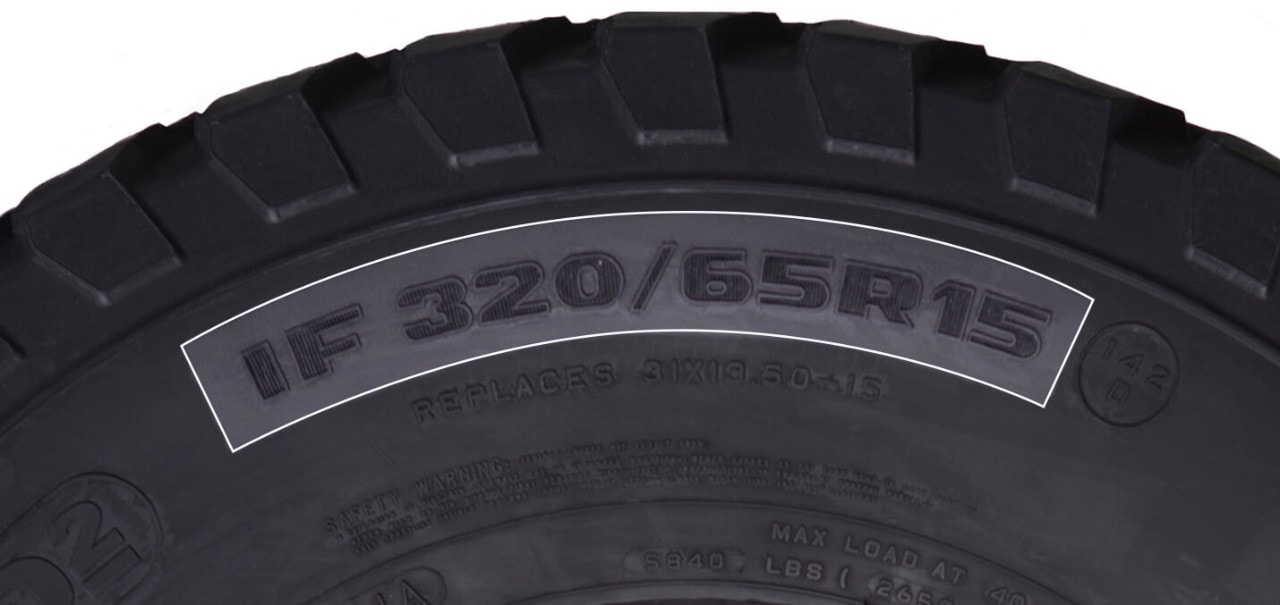Tire Expert Center
Measuring Tractor Tire Size: What You Need to Know
Tractors and implements require specific tire sizes, constructions, and tread patterns to keep it operating at peak efficiencies. Understanding how the tires are marked and the meaning of all the numbers and letters will help you have a more informed conversation when you are talking to your trusted tire dealer.

Why Tire Size is Important
Even the best tractor you own can be rendered useless, if the wrong tire size is installed. On Mechanical Front Wheel Drive (MFWD or FWD) tractors, the rear and front tires must maintain a proper rolling circumference ratio. If the ratio between the front and rear tires change, it can cause damage to the driveline or reduce the wear life of the tire. It is acceptable to increase or decrease the overall diameter on the rear tires, but the front tires will also need to be changed. Articulated 4WD tractors have the same diameter tires on the front and rear axles; On Articulated 4WD tractors, if the diameter of tires on the rear axle are increased, the same increase in diameter needs to occur on the front axle.
Finding Tire Size on the Sidewall
All Firestone Ag tires include the tire size on the sidewall. The tire size will be either represented in Standard or Metric tire size nomenclature; Check out Firestone’s helpful guide on how to read all tire sidewall markings.

How to Measure Tractor Tires by Hand
If you can’t read the tire size from the sidewall, you can manually measure the tire. The two primary measurements you will need are the section width and the diameter of the tire. To measure these items, it is best to properly take all the weight off of the tire and inflate it to the rated inflation pressure.
How to Measure Tire Section Width
For the section width of the tire, you want to measure the maximum width of the tire which is usually found in the sidewall not the tread. Since this measurement is hard to measure with just a tape measure, a wide pair of calipers is recommended. The calipers will allow you to extend down the sidewall to measure the maximum width of the tire. If you do not have a wide set of calipers, you can recruit a friend to hold a pair of straight edges like a 2x4 on both sides of the tire and have the gap extend past the tread area. You can then take a tape measure and measure the gap between the 2x4s. This measurement will be the section width of your tire.
How to Measure Tire Diameter
For the diameter of the tire, you want to measure the circumference at the centerline of the tire. The easiest way to measure this distance is using a string. Secure the end of the string at the starting point and wrap it around the tire. Mark the string where it intersects the starting point. Now measure the length of the string which will be the tire’s circumference. Divide the circumference measurement by 3.14 and that value is the diameter of the tire.
Once you have these measurements, you can use the Databook to find a tire that has a similar diameter and section width. Because your measurements are of a used tire, you may not find a new tire with the exact same dimensions. Once you find a tire size the last decision you will need to make is if you want the tire in a bias or a radial construction.
When to Use Radial or Bias-Ply on Front Tractor Tires
If you’re looking in the automotive industry, you’ll see the argument of bias-ply vs. radial has long been decided, with radial tires reigning supreme. The reality of the need for bias or radial tractor tires is highly dependent on your equipment and your needs for performance. Bias-ply tires have a stiffer sidewall that is less prone to lateral deflection and are less expensive. Bias tires are widely used for farm chores.
Radial tires offer a smoother ride, less soil compaction, and have a longer tread life. Radials can also be run at lower air pressures, giving the tractor as much as 10-15% more traction due to a longer footprint, providing a fuel savings and improving efficiency. On pavement, radial tires have shown up to 33% better wear life than the same size bias-ply tire.
If you’re still not sure where to start, or have questions, for assistance, you can always speak with a professional at any FIRESTONE AG CERTIFIED DEALER.
